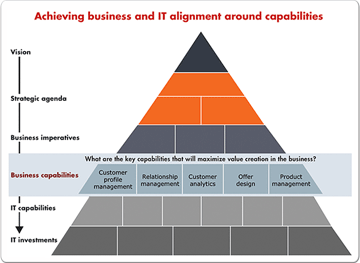Article
Information technology organizations and the businesses they support do not occupy parallel universes, but business leaders can be forgiven for thinking they might. A Bain & Company survey of more than 500 senior executives found that despite devoting enormous resources and energy to align IT investments with their most important business needs, fewer than one in five felt their efforts were succeeding.
Trouble typically starts when business units hand off their strategy to IT at too high a level. The broad goals are not concrete enough to be converted into well-informed IT decisions. In response, the proposals IT develops are defined at too low a level—often as a one-year operating plan rather than a comprehensive program to reach a strategic destination.
The consequences can be severe: The organization wastes money on the wrong IT investments. It is slow to bring new products and initiatives to market. And it defers making improvements because IT lacks the full support of the business which, in turn, fails to achieve critical objectives.
There is a better way. Effective alignment can occur only when IT and business strategy are anchored in clearly articulated business capabilities. Capabilities are the specific skills needed to achieve competitive leadership. They are dynamic and give the organization an ability to adapt to changing market conditions. Supporting business capabilities permits IT to respond flexibly to essential business needs.
Consider customer segmentation, a critical capability for many companies in order to grow. An IT organization built around capabilities enables the business to target attractive new customer segments in an environment of changing products, prices and consumer tastes. These goals require IT, in turn, to build capabilities for integrated data storage; common platforms for various channel, product and security needs; and dynamic end-user computing. In short, organizing around capabilities ensures that business priorities trigger key IT decisions.
Leading companies typically follow a five-step process for unlocking IT's full potential to deliver business value:
- Define business imperatives and the capabilities that underpin them.
- Identify IT capabilities that support business capabilities and plug gaps.
- Design the operations and technology architecture.
- Develop the IT-strategy roadmap.
- Reallocate IT spending as business priorities evolve.
Click here to read full article.
The authors are all partners with Bain & Company and members of the firm's Information Technology practice. Donie Lochan is based in New Delhi; Rudy Puryear, the IT practice leader, is based in Chicago; Sachin Shah is based in London; and Arpan Sheth is based in Mumbai.
Additional articles appearing in this edition of the Results Brief newsletter:
Flexible work models: How to bring sustainability to a 24/7 world
By Julie Coffman and Russ Hagey
Many companies offer flexible work models like telecommuting and leaves of absence to retain talent-especially women in challenging jobs. But our research shows that it takes real commitment from the top as well as tailored flex programs that meet employees' specific needs in order to succeed.
Making change happen: Shaping the future with women's voices
Women leaders in business, government and NGOs gathered at the Women's Forum Global Meeting in Deauville, France, in October to map out common ground on pressing issues in business, the environment, global health, politics and leadership roles for women. As a partner to the Women's Forum, Bain produced a summary of the ideas discussed that are most likely to deliver results.
Customer loyalty in retail banking
by Gerard du Toit, Andrew Schwedel and Beth Johnson
Organic growth rooted in strong customer relationships will be the best path forward for retail banks. Bain & Company polled more than 89,000 North American account holders to see which banks create the strongest customer relationships and how they do it.
